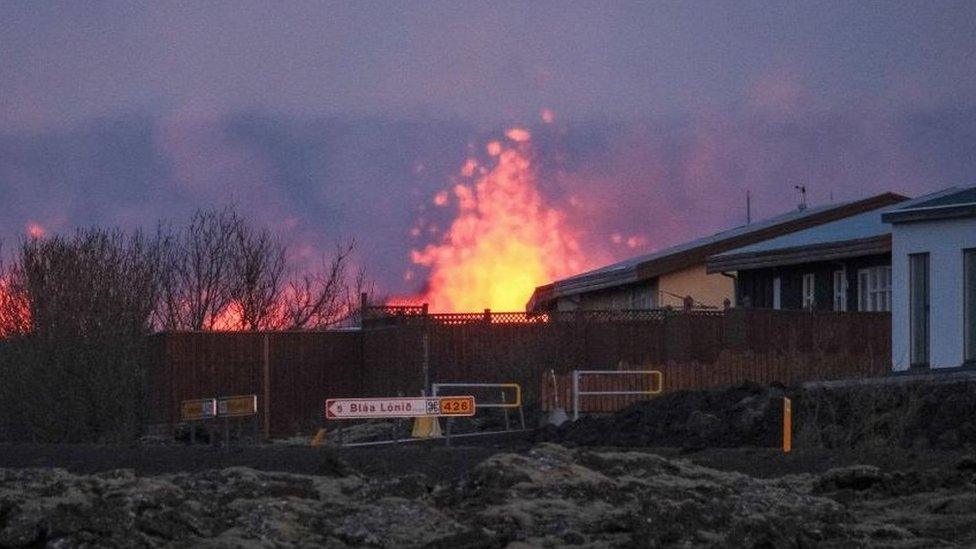Iceland violent volcanic flare-up triggers state of emergency
- Published
Watch: Iceland volcano spews lava in eruption on the Reykjanes Peninsula
A state of emergency has been declared in southern Iceland after another volcanic eruption on the Reykjanes Peninsula - the fourth since December.
The powerful and fast lava flows began late on Saturday - but flows have been "slow and steady" since Sunday morning, the Icelandic Met Office (IMO) said.
Lava reached the eastern defences around the small, mostly evacuated town of Grindavik.
The IMO said lava was 200m (650 feet) from the region's water pipe.
The distribution pipe is close to the Svartsengi power plant, a geothermal plant that provides hot water for most of the Reykjanes Peninsula.
The head of department at the Norwegian Meteorological agency said there could be "dangerous" consequences if lava reaches the sea as it flows southwards.
Quoted by the Iceland's public broadcaster (RUV), Kristin Jonsdottir explained that "if lava, which is alkaline, comes into contact with sea water, chlorine fumes can be produced".
Another concern, she warned, is that "minor explosions" could occur if lava becomes unstable as it interacts with seawater.

Activity around the fissure - initially 3km long (1.9 miles) - has dissipated.
The director of Iceland's civil defence, Vídir Reynisson, said all that could be done to prepare for the flow of lava had been done, and the biggest concern was the impact on infrastructure.
Pools of lava gathering near defences were also of concern, he added.
On Sunday he told reporters that it was possible that all roads to Grindavik would be closed.
The eruption began after 20:23 local time (20:23 GMT) on Saturday, north of Grindavik, according to the country's met office.
This is a similar location to the eruption that began on 8 December.
Footage of the explosion showed clouds of smoke and glowing magma oozing and bubbling from vents in the earth.
The explosion has not affected the main international airport, which lies to the north-west of Grindavik.
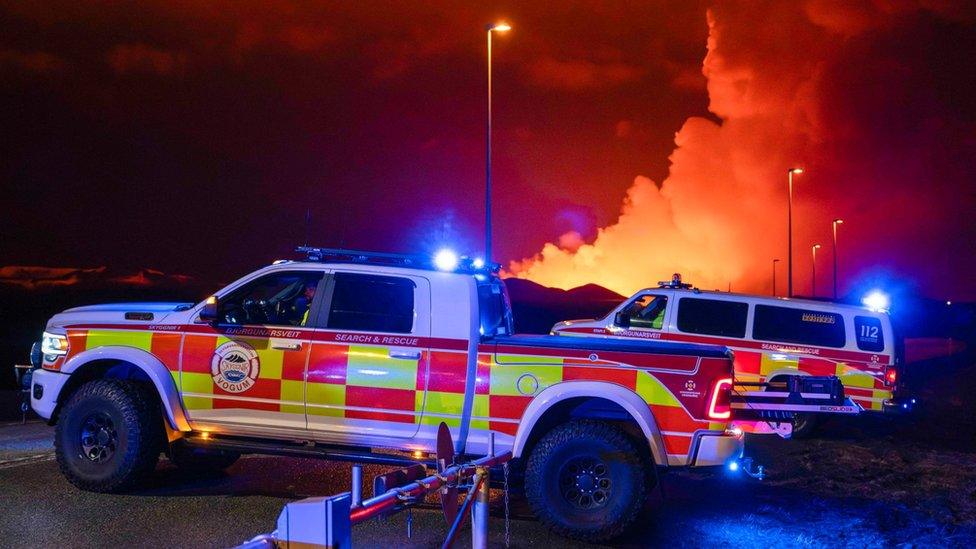
Emergency vehicles are pictured as molten lava flows out from a fissure on the Reykjanes peninsula
Geophysicist Magnus Tumi Gudmundsson, who was among those to fly over the affected areas in a helicopter, told local media that Saturday's eruption was the most powerful so far.
Two lava streams have been moving west and south. Local media reported that lava from the latter had reached Grindavik's eastern defence walls.
Mr Gudmundsson said it was also possible lava could flow into the sea, but that this may not happen if the volcanic activity eases.
The IMO earlier said this lava bed was "significantly wider" than in February, when an earlier eruption caused lava to flow in a similar direction.
Many protective embankments have been built around both, the head of the Reykjavik-based Nordic Volcanological Centre, Rikke Pedersen, told Reuters.
There are concerns that fibre optic cables on the road could be damaged - causing disruption to phone and internet services.
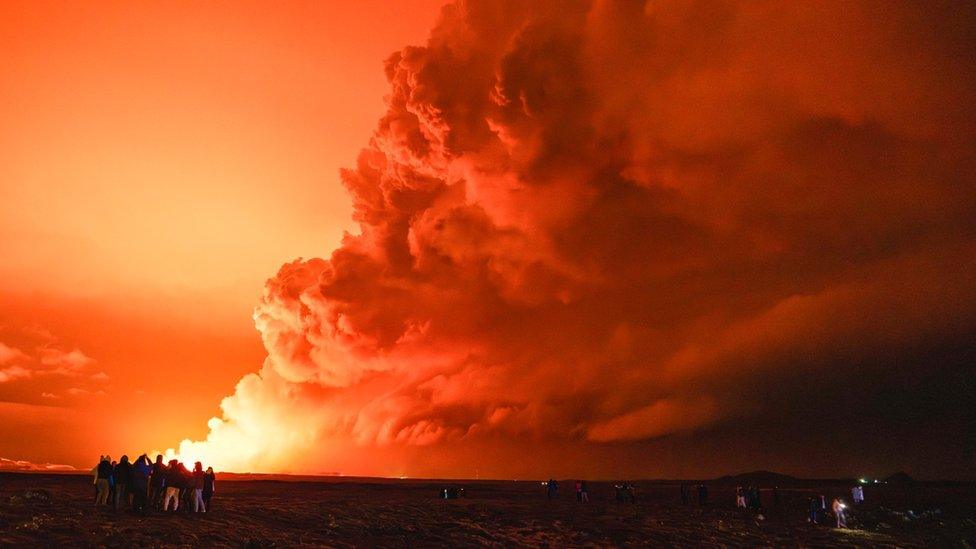
People seen gathering on Saturday to watch the lava flow from a fissure caused by a volcanic eruption
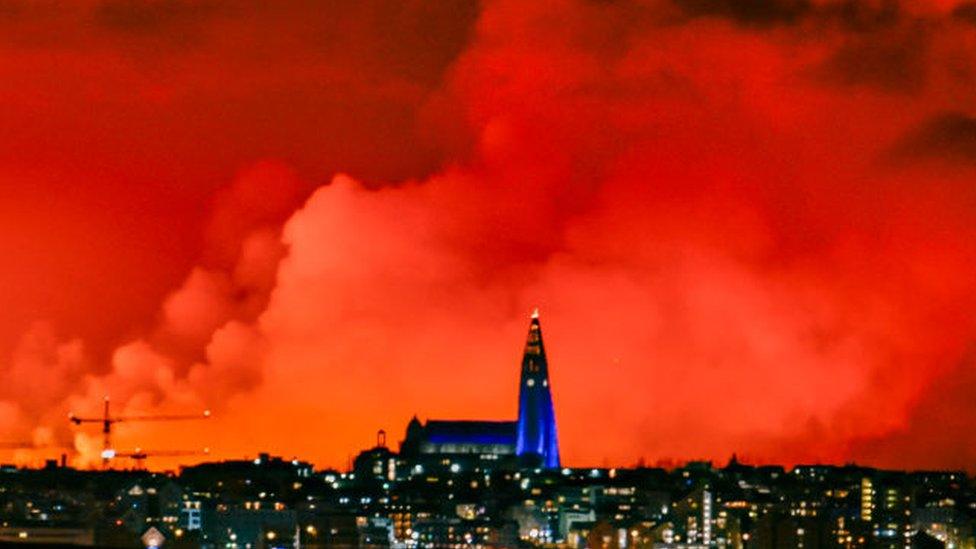
The skyline of Reykjavik turns orange following the eruption
The lava was heading in the direction of the Blue Lagoon, which is closed until further notice as a precaution.
There were between 500-600 people in the area when Saturday's eruption happened, Ms Pedersen said.
Between five and 10 homes in Grindavik were also cleared.
The town's roughly 4,000 residents were only allowed to return to their homes about a month ago after an eruption in January saw magma spread into the town, destroying three homes.
Most of them have chosen not to return. But few have stayed.
In an interview with the BBC World Service's Newsroom programme, Icelandic journalist Lara Omarsdottir said most of the people living in Grindavik have left already.
Asked whether people will move away from Grindavik, she said many will move and "about 30% have already decided to sell their properties".
But some "10-20%" are not going anywhere, she added, "they just want to live in Grindavik in spite of this".
Iceland has 33 active volcano systems and sits over what is known as the Mid-Atlantic Ridge, the boundary between two of the largest tectonic plates on the planet.
The last time the Reykjanes Peninsula had a period of volcanic activity was 800 years ago - and the eruptions went on for decades.
This is now the seventh eruption since 2021, and scientists believe the area is entering a new volcanic era that could last for decades or even centuries.

Are you in Iceland? Please share your experiences by emailing haveyoursay@bbc.co.uk, external.
Please include a contact number if you are willing to speak to a BBC journalist. You can also get in touch in the following ways:
WhatsApp: +44 7756 165803
Tweet: @BBC_HaveYourSay, external
Please read our terms & conditions and privacy policy
If you are reading this page and can't see the form you will need to visit the mobile version of the BBC website to submit your question or comment or you can email us at HaveYourSay@bbc.co.uk, external. Please include your name, age and location with any submission.
- Published8 February 2024
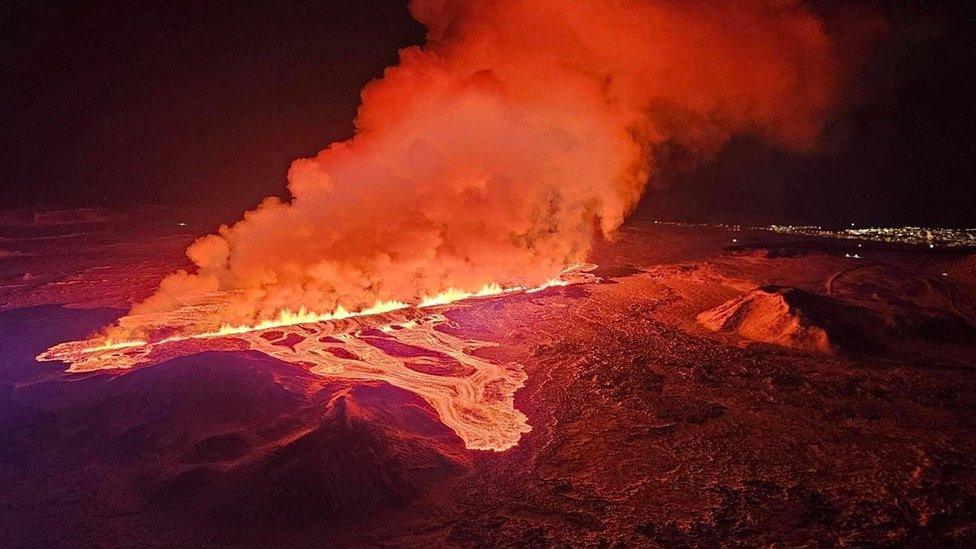
- Published15 January 2024
